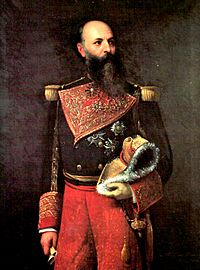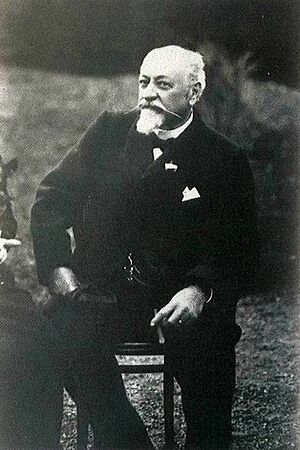Antonio Guzmán Blanco facts for kids
Quick facts for kids
Antonio Guzmán Blanco
|
|
|---|---|

Portrait by Martín Tovar y Tovar
|
|
| President of Venezuela | |
| In office 15 September 1886 – 8 August 1887 |
|
| Preceded by | Joaquín Crespo |
| Succeeded by | Hermógenes López |
| In office 26 February 1879 – 26 April 1884 |
|
| Preceded by | José Gregorio Valera |
| Succeeded by | Joaquín Crespo |
| In office 27 April 1870 – 27 February 1877 |
|
| Preceded by | Guillermo Tell Villegas |
| Succeeded by | Francisco Linares Alcántara |
| Minister of Foreign Affairs | |
| In office 24 July 1867 – 3 October 1867 |
|
| President | Juan Crisóstomo Falcón |
| Preceded by | Rafael Seijas |
| Succeeded by | Rafael Seijas |
| In office 21 January 1864 – 6 February 1864 |
|
| President | Juan Crisóstomo Falcón |
| Preceded by | Guillermo Tell Villegas |
| Succeeded by | Antonio María Salom |
| In office 25 July 1863 – 7 August 1863 |
|
| President | Juan Crisóstomo Falcón |
| Preceded by | Jesús María Morales Marcano |
| Succeeded by | Guillermo Tell Villegas |
| Personal details | |
| Born | 28 February 1829 Caracas, Great Colombia |
| Died | 28 July 1899 (aged 70) Paris, France |
| Resting place | National Pantheon of Venezuela |
| Political party | Liberal Party |
| Spouse | Ana Teresa Ibarra |
| Signature | |
Antonio José Ramón de La Trinidad y María Guzmán Blanco (February 28, 1829 – July 28, 1899) was an important Venezuelan leader. He was a military general, a diplomat, and a politician. He served as the president of Venezuela three times. These terms were from 1870 to 1877, 1879 to 1884, and 1886 to 1887. He was also a general during the Venezuelan Federal War. Guzmán Blanco was part of a political group called Liberalismo Amarillo.
Contents
Early Life and Education
Guzmán was born in Caracas, Venezuela. His father, Antonio Leocadio Guzmán, was a journalist and politician. His father also helped start the Liberal Party. His mother was Carlota Blanco Jerez de Aristeguieta.
Political Career
Military Leader and Diplomat
Guzmán Blanco was once sent away from Venezuela. He joined General Juan Crisóstomo Falcón in a fight to return. Guzmán became Falcón's main secretary. After a major battle in 1860, Guzmán went to the Caribbean to ask for help.
In 1861, he returned with Falcón. They fought many battles. In 1863, they signed a peace agreement. This agreement led to Falcón becoming president and Guzmán becoming vice president. Guzmán also served as the Minister of Finance. He traveled to London to get a loan for Venezuela.
From 1863 to 1866, Guzmán was also the Venezuelan ambassador to Spain. He also served as the Minister of Foreign Affairs of Venezuela several times.
First Term as President (1870-1877)
After returning to Venezuela, Guzmán was briefly in charge. He was later elected president of the congress. When Falcón's government was overthrown in 1868, Guzmán left the country. But he led a revolution in 1869. In 1870, he became the temporary president. He ruled Venezuela for seven years with a lot of power.
In 1871, Guzmán created the Territorio Colón. This new territory included the Los Roques archipelago and other islands.
He also started many important building projects. The Palacio Federal Legislativo, also known as the Capitolio, was built in 1872. This building in Caracas now houses the National Assembly. In 1876, the Universidad de Caracas was moved to a new building. Its old colonial style was changed to a Neo-Gothic style.
Second Term as President (1879-1884)
After his first term, his successor, General Francisco Linares Alcántara, died in 1878. This led to some uprisings. Guzmán then took over the government again.
During this time, he made education a priority. In 1880, he made free and compulsory education for children aged 7 to 14. In 1881, he created the Ministry of Public Instruction. In 15 years, the number of primary schools grew a lot. The number of children attending school also increased greatly.
He also established the Order of the Liberator in 1880. This was Venezuela's highest award for service to the country. In 1881, "Gloria al Bravo Pueblo" was adopted as Venezuela's national anthem.
In 1883, General Joaquín Crespo, a friend of Guzmán, became president. Guzmán then became the ambassador to France. He lived a very fancy life in Paris.
Third and Final Term (1886-1887)
In 1886, Guzmán became president for the third time.
During his time as a leader, Venezuela saw a lot of development. Caracas especially grew a lot. Coffee production in Venezuela also increased quickly. This was helped by loans from other countries.
Some historians say that Guzmán Blanco's government was stable but had problems. They say he used his power for personal gain. He also had disagreements with the Catholic Church. He reduced the church's power and took some of its property. When people were unhappy with his rule, he ordered the body of Simón Bolívar to be moved. Bolívar was reburied in the National Pantheon of Venezuela. Guzmán did this to show he supported Bolívar's ideas, even though they had different views.
His successor, Hermógenes López, was also thought to be under his influence.
Legacy and Reforms
Even though Guzmán's rule was very strong, he brought many important changes. His government created the modern Venezuelan money, the Venezuelan bolívar. He also brought back the national anthem. A second national census was done under his rule.
He also oversaw the building of the La Guaira and Caracas Railway. The Venezuelan Academy of the Language was founded. Telephone service started between Caracas and La Guaira. He encouraged farming and education. He also supported trade and built important public works. These included the National Pantheon, the Capitol, and the Municipal Theater.
Guzmán Blanco is sometimes called a "strongman" politician. This means he was a leader who held a lot of power. He was also a freemason. He significantly reduced the power of the Roman Catholic Church in Venezuela.
Personal Life
Guzmán was married to Ana Teresa Ibarra Urbaneja. She was the First Lady of Venezuela during his terms. Her sister, María Ibarra Urbaneja, married the Venezuelan banker Manuel Antonio Matos. Guzmán was first buried in Passy Cemetery in France. Later, his remains were moved to the National Pantheon of Venezuela.
Towards the end of his life, Guzmán built a country house. It was in the region of Antímano. He called it "La Pequeña Versalles" (Little Versailles). This house was declared a National Monument. After his death, it was not used for a long time. In 2004, it was restored and became a cultural and sports center.
Images for kids
See Also
 In Spanish: Antonio Guzmán Blanco para niños
In Spanish: Antonio Guzmán Blanco para niños
- List of presidents of Venezuela
- History of Roman Catholicism in Venezuela
- List of Ministers of Foreign Affairs of Venezuela
- List of state leaders in 1870 - 1871 - 1872 - 1873 - 1874 - 1875 - 1876 - 1877
- List of state leaders in 1880 - 1887
- List of people on the postage stamps of Venezuela
- List of people from Caracas
- List of Venezuelans
- List of ambassadors of Venezuela to Spain
- List of Freemasons (A–D)










